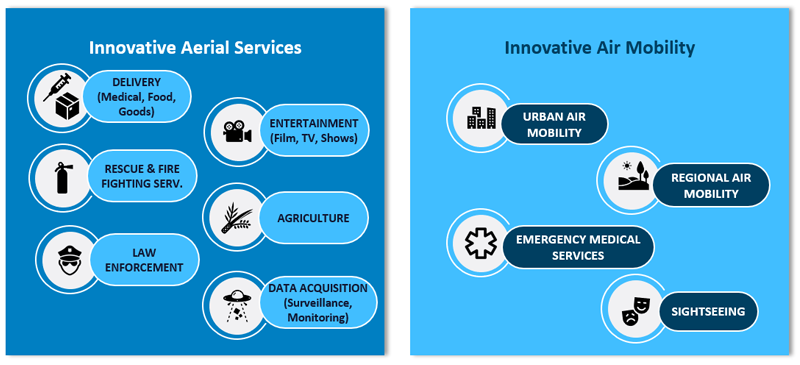What are VTOLs and Drones, UAM, AAM, and IAS ?
A new age of aviation is dawning. In 2017, EASA embarked on a journey by accepting applications for Type Certification of electric vertical take-off and landing (VTOL) aircraft. These developments aimed to usher in a new era of urban airspace connectivity. Simultaneously, Unmanned Aircraft Systems (‘Drones’ or ‘UAS’) and Urban Air Mobility (UAM) initiatives were taking flight in various corners of the globe.
EASA was charged with crafting a new and innovative, risk-based, and operation-centric regulatory framework for drones. This endeavour culminated in a pioneering set of European UAS regulations, facilitating operations in both 'open' and 'specific' categories (addressing lower-risk civil drone operations and riskier civil drone operations respectively). EASA also began to create the 'U-space,' the European Unmanned Traffic Management system, which paved the way for deployment of the first generation of U-space airspace and related services across the European Union.
As this is a completely new area of aviation, it has its own specialist terms. This an overview of other common terms used in this area which you can use as a reference when reading on this topic:
- Innovative Aerial Services (IAS): the set of operations and/or services that are of benefit to the citizens and to the aviation market, and that are enabled by new airborne technologies; the operations and/or services include both the transportation of passengers and/or cargo and aerial operations (e.g. surveillance, inspections, mapping, telecommunications networking, etc.);
- Innovative Air Mobility (IAM): the safe, secure and sustainable air mobility of passengers and cargo enabled by new-generation technologies integrated into a multimodal transportation system;
Innovative Air Mobility and Services

- Urban Air Mobility (UAM): the subset of IAM operations conducted into, out of or within urban environments.
- Electrically powered aircraft capable of Vertical Take-off and Landing (eVTOL). These novel aircraft designs do not fall under one of the previously known categories of aeroplanes or helicopters, but have the capability to vertically take-off and land, have specific (distributed) propulsion features, and may be operated without a pilot at some time in the future.
- VTOL-capable aircraft (VCA): a power-driven, heavier-than-air aircraft, other than an aeroplane or rotorcraft, capable of performing vertical take-off and landing by means of lift and thrust units used to provide lift during take-off and landing.
- Unmanned Aerial System (UAS), also known as an Unmanned Aerial Vehicle (UAV) or simply a drone, consists of three key components:
- Unmanned Aircraft (UA): This refers to an aircraft that operates autonomously or is remotely piloted without a human pilot on board. UAs can vary in size, from hand-launched models to purpose-built vehicles comparable in size to conventional fixed-wing or rotary-wing aircraft.
- Control System: The control system can be either autonomous or human-operated. It is typically located on the ground, on a ship, or even on another airborne platform. This system communicates with the UAV and provides commands for its operation.
- Command and Control (C2) System: Also known as a communication, command, and control (C3) system, this component links the control system to the UAV. It facilitates communication, data exchange, and coordination between the ground operator and the aircraft.
Pre-registration
Are you representing a municipality or a manufacturer and wish to register your drone in the IAM Hub Design Database?
Fill in our pre-registration form
Any feedback?
Your feedback is welcome to this page and other IAM Hub deliverables.